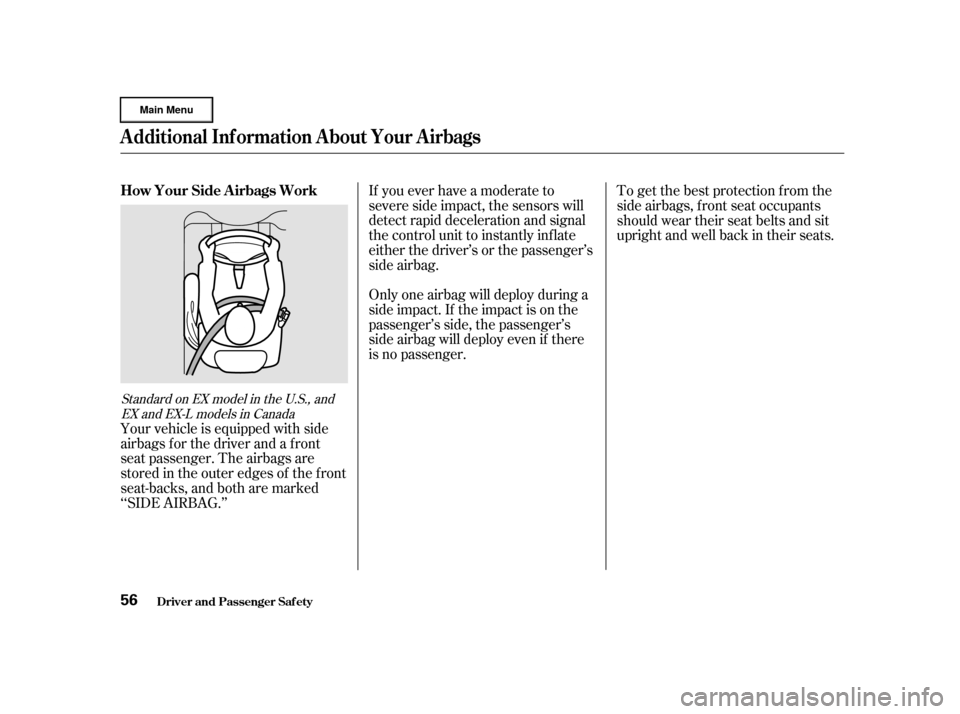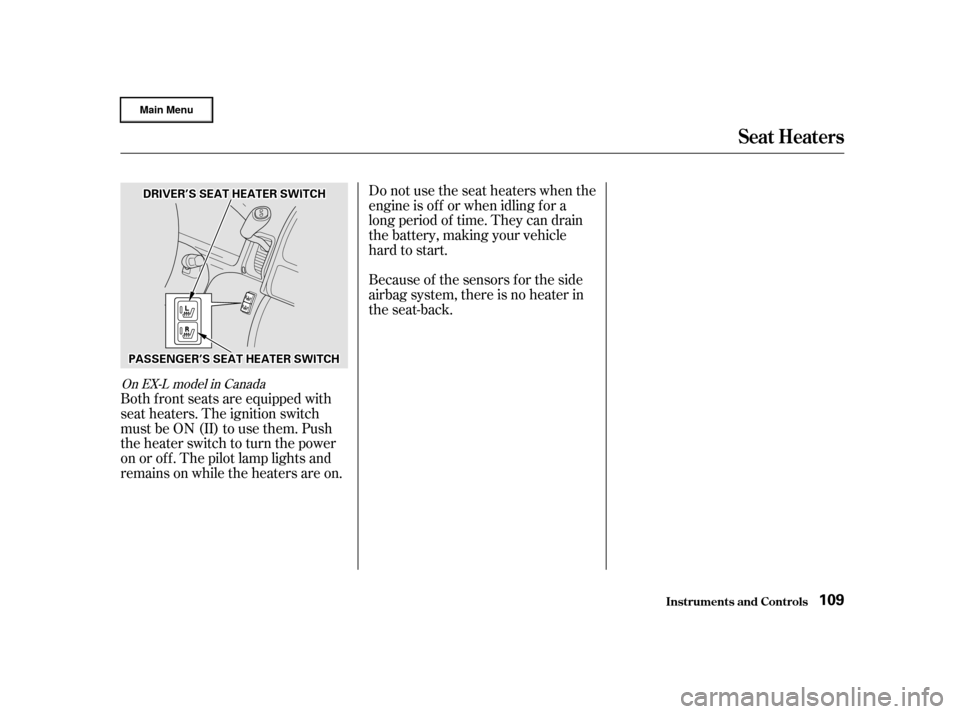sensor HONDA CR-V 2002 RD4-RD7 / 2.G Owners Manual
[x] Cancel search | Manufacturer: HONDA, Model Year: 2002, Model line: CR-V, Model: HONDA CR-V 2002 RD4-RD7 / 2.GPages: 372, PDF Size: 4.49 MB
Page 58 of 372

Your Supplemental Restraint System
(SRS) includes:An indicator light on the
instrument panel that alerts you to
a possible problem with the
system (see page ).
Emergency backup power in case
your vehicle’s electrical system is
disconnected in a crash.
Two f ront airbags. The driver’s
airbag is stored in the center of
the steering wheel; the f ront
passenger’sairbagisstoredinthe
dashboard. Both are marked ‘‘SRS
AIRBAG.’’
Automatic seat belt tensioners
(see page ).
Sensors that can detect a
moderate to severe frontal
collision.
If you ever have a moderate to
severe f rontal collision, the sensors
will detect the vehicle’s rapid
deceleration If the rate of
deceleration is high enough, the
control unit will instantly inf late the
front airbags and activate the
automatic seat belt tensioners.
A sophisticated electronic system
that continually monitors and
records inf ormation about the
sensors, the control unit, the
airbag activators, and driver and
passenger seat belt use when the
ignition is ON (II). 52
57
SRS Components
How Your Front A irbags Work
Additional Inf ormation About Your Airbags
Driver and Passenger Saf ety54
Page 59 of 372

The total time for inflation and
def lation is approximately one-tenth
of a second, so f ast that most
occupants are not aware that the
airbags deployed until they see them
lying in their laps.
During a f rontal crash, your seat
belts help restrain your lower body
and torso. Your airbag provides a
cushion to help restrain and protect
your head and chest.
Af ter inf lating, the f ront airbags
immediately def late, so they won’t
interf ere with the driver’s visibility,
or the ability to steer or operate
other controls.After a crash, you may see what
looks like smoke. This is actually
powder f rom the airbag’s surf ace.
Although the powder is not harmf ul,
people with respiratory problems
may experience some temporary
discomf ort. If this occurs, get out of
the vehicle as soon as it is saf e to do
so.
For additional information on how
your airbags work, ask your dealer
f or a copy of the booklet titled For additional information on how
your airbags work, see the booklet
titled
that came with your
owner’s manual.
Since both airbags use the same
sensors, both airbags normally
inf late at the same time. However, it
is possible f or only one airbag to
inf late.
This can occur when the severity of
a collision is at the margin, or
threshold, that determines whether
or not the airbags will deploy. In
such cases, the seat belt will provide
suf f icient protection, and the
supplemental protection of f ered by
the airbag would be minimal.SRS:
What You Need to Know About Airbags
.
SRS: What You Need to Know
About Airbags
U.S. Owners
Canadian Owners
Additional Inf ormation About Your Airbags
Driver and Passenger Saf ety55
Page 60 of 372

If you ever have a moderate to
severe side impact, the sensors will
detect rapid deceleration and signal
the control unit to instantly inf late
either the driver’s or the passenger’s
side airbag.
Only one airbag will deploy during a
side impact. If the impact is on the
passenger’s side, the passenger’s
side airbag will deploy even if there
is no passenger.To get the best protection f rom the
side airbags, front seat occupants
should wear their seat belts and sit
upright and well back in their seats.
Your vehicle is equipped with side
airbags f or the driver and a f ront
seat passenger. The airbags are
stored in the outer edges of the f ront
seat-backs, and both are marked
‘‘SIDE AIRBAG.’’
Standard on EX model in the U.S., and EX and EX-L models in Canada
Additional Inf ormation About Your Airbags
Driver and Passenger Saf ety
How Your Side A irbags Work
56
Page 78 of 372

This shows the temperature of the
engine’s coolant. During normal
operation, the pointer should rise
from the bottom white mark to about
the middle of the gauge. In severe
driving conditions, such as very hot
weather or a long period of uphill
driving, the pointer may rise to the
upper white zone. If it reaches the
red (Hot) mark, pull saf ely to the
side of the road. Turn to page f or
instructions and precautions on
checking the engine’s cooling
system.
The temperature sensor is located in
the f ront bumper. Theref ore, the
temperature reading can be af f ected
by heat ref lection f rom the road sur-
f ace, engine heat, and the exhaust
f rom the surrounding traf f ic. This
can cause the temperature reading
not to be correct when your speed is
under 19 mph (30 km/h).
This shows how much f uel you have.
It is most accurate when the vehicle
is on level ground. It may show
slightly more or less than the actual
amount when you are driving on
curvy or hilly roads.
The needle returns to the bottom
after you turn off the ignition. The
gauge shows the f uel level reading
immediately af ter you turn the
ignition switch back ON (II).
When the outside temperature goes
down below 37°F (3°C) the f irst
time, the temperature reading blinks
about ten times to show you the
outside temperature is low. In certain
weather conditions, temperature
readings near f reezing 32°F (0°C)
couldmeanthaticeisformingonthe
road surf ace. 323
Temperature Gauge
Fuel Gauge
Gauges
Inst rument s and Cont rols74
Avoid driving with an extremely low
f uel level. Running out of f uel could
cause the engine to misf ire, damaging
the catalytic converter.
Page 113 of 372

Both f ront seats are equipped with
seat heaters. The ignition switch
must be ON (II) to use them. Push
the heater switch to turn the power
on or of f . The pilot lamp lights and
remains on while the heaters are on.Do not use the seat heaters when the
engine is of f or when idling f or a
long period of time. They can drain
the battery, making your vehicle
hard to start.
Because of the sensors f or the side
airbag system, there is no heater in
the seat-back.
On EX-L model in Canada
Seat Heaters
Inst rument s and Cont rols109
P P
A
A S
SSSEEN
NG GEER
R’ ’SS S
SEEA
A T
T H
HE
EA
A T
TE
ER
R S
SWWI ITT C
CH H
D
D
R
RIIVV E
ER
R’ ’SS S
SEEA
A T
T H
HE
EA
A T
TE
ER
R S
SWWI ITT C
CH H
Page 308 of 372

Use a high-pressure spray to clean
the underside of your vehicle. This
is especially important in areas
that use road salt in winter. It is
also a good idea in humid climates
and areas subject to salt air.
Vehicles equipped with ABS have
a sensor and wiring at each wheel.
Be caref ul not to damage them.
Many corrosion-preventive measures
are built into your Honda. You can
help keep your vehicle f rom
corroding by perf orming some
simple periodic maintenance:
Repair chips and scratches in the
paint as soon as you discover them.
Two f actors normally contribute to
causing corrosion in your vehicle:
Moisture trapped in body cavities.
Dirtandroadsaltthatcollectsin
hollows on the underside of the
vehicle stays damp, promoting
corrosion in that area.
Removal of paint and protective
coatings f rom the exterior and
underside of the vehicle. Inspect and clean out the drain
holes in the bottom of the doors
and body.
Check the floor coverings for
dampness. Carpeting and f loor
mats may remain damp f or a long
time, especially in winter. This
dampness can eventually cause
the f loor panels to corrode.Have the corrosion-preventive
coatings on the underside of your
vehicle inspected and repaired
periodically.
1.
2.
Corrosion Prot ect ion
Appearance Care304
Page 351 of 372

If you are planning to take your
Honda outside the U.S. or Canada,
contact the tourist bureaus in the
areas you will be traveling in to f ind
out about the availability of unleaded
gasoline with the proper octane
rating.
If unleaded gasoline is not available,
be aware that using leaded gasoline
in your Honda will af f ect perf or-
mance and fuel mileage, and damage
its emissions controls. It will no
longer comply with U.S. and
Canadian emissions regulations, and
will be illegal to operate in North
America. To bring your vehicle back
into compliance will require the re-
placement of several components,
such as the oxygen sensors and the
three way catalytic converter. These
replacements are not covered under
warranty.
Driving in Foreign Countries
T echnical Inf ormation347
Page 353 of 372

The exhaust emissions controls
include three systems: PGM-FI,
Ignition Timing Control and Three
Way Catalytic Converter. These
three systems work together to
control the engine’s combustion and
minimize the amount of HC, CO, and
NOx that comes out the tailpipe. The
exhaust emissions control systems
are separate from the crankcase and
evaporative emissions control
systems.The emissions control systems are
covered by warranties separate from
the rest of your vehicle. Read your
warranty manual for more inf orma-
tion. The emissions control systems are
designed and certif ied to work to-
gether in reducing emissions to
levels that comply with the Clean Air
Act. To make sure the emissions
remain low, you should use only new
genuine Honda replacement parts or
their equivalent f or repairs. Using
lower quality parts may increase the
emissions f rom your vehicle.
This system constantly adjusts the
ignition timing, reducing the amount
of HC, CO, and NOx produced.
The three way catalytic converter is
in the exhaust system. Through
chemical reactions, it converts HC,
CO, and NOx in the engine’s exhaust
to carbon dioxide (CO ), dinitrogen
(N ), and water vapor. The PGM-FI System uses sequential
multiport f uel injection.
It has three subsystems: Air Intake,
Engine Control, and Fuel Control.
The Engine Control Module (ECM)
or the Powertrain Control Module
(PCM) uses various sensors to
determine how much air is going
into the engine. It then controls how
much f uel to inject under all operat-
ing conditions.
2
2
Replacement Parts
Exhaust Emissions ControlsPGM-FI Syst em
Ignit ion T iming Cont rol Syst emThree Way Catalytic Converter
Emissions Cont rols
T echnical Inf ormation349